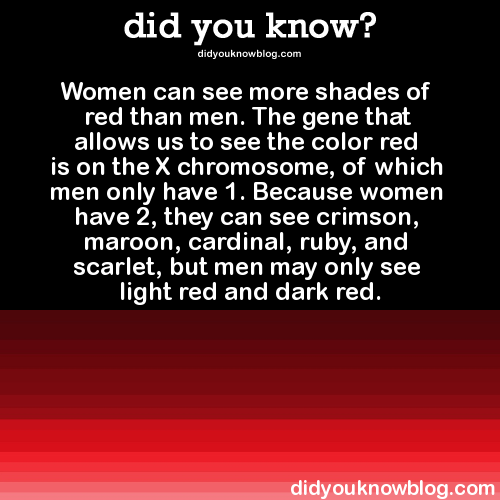
Women can see more shades of red than men. The gene that allows us to see the color red is on the X chromosome, of which men only have 1. Because women have 2, they can see crimson, maroon, cardinal, ruby, and scarlet, but men may only see light red and dark red. Source
This explains that argument my parents got into about this bag that my dad insisted was red and my mom was like hells to the no, it’s freaking maroon!
this explains everything
Hello yes XY woman here (trans woman) i can see all shades of red in this picture.
BOOM GOES THE DYNAMITE
OP best be prepared to pay for a whole bunch of ppl’s karyotype tests =)
Pffft, yeah nope.
Heterozygous folks (with XY karyotypes) can see red with normal variation. The OPN1LW gene, which is found on the X chromosome and generates the red-sensitive opsin protein, usually only comes in one copy even in homozygous (XX) individuals. Having two X chromosomes doesn’t inherently increase your red-sensitive opsins. People are way more likely more copies of the gene that codes for green-sensitive opsins, and a much more variable number.
What IS true is that mutations, reduplications, deletions and other anomalies in this part of the chromosome are common; these often lead to various forms of color blindness, which are often heritable and more or less common depending on your karyotype and the exact condition.
Additionally, there are more aspects to color perception than just your cone cells. The brain is heavily involved, and it’s sensitive to all kinds of other biological indicators. It’s even sensitive to culture and language!
Indeed it is; language and culture are incredibly important in how you perceive colour. The Himba of Northern Namiba were included in a BBC Documentary about colour perception because their perception of colour is significantly different to that of English speakers. For example, ‘zoozu’ includes all of the colours most English speakers would call: dark blue, dark green, dark brown, dark purple, dark red or black.
On the other hand, to Himba people, this:

Has a stand-out obvious different square.
(via boing boing: http://boingboing.net/2011/08/12/how-language-affects-color-perception.html)
